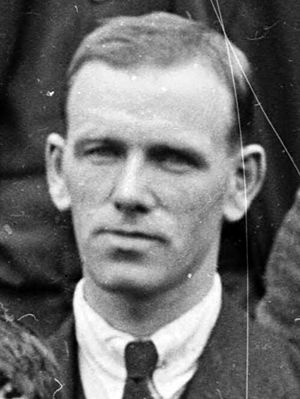Seamus Hughes (trade unionist) facts for kids
Quick facts for kids
Seamus Hughes
|
|
|---|---|

Hughes in August 1918
|
|
| Personal details | |
| Born |
James Joseph Hughes
May 18, 1881 |
| Died | January 23, 1943 (aged 61) |
| Political party |
|
| Occupation |
|
| Military service | |
| Branch/service | Irish Citizen Army |
| Battles/wars | Easter Rising |
Seamus Hughes was an important Irish person. He was born in 1881 and passed away in 1943. He worked as a trade union leader, fought for Ireland's freedom, wrote music, and served the public.
Contents
Seamus Hughes's Life Story
Early Life and Family
Seamus Hughes was born in Dublin, Ireland, in 1881. His father was a baker. Sadly, his mother passed away when he was young. Seamus went to O'Connell School. He also studied in France for a while. Later, he taught French and worked as a clerk. In 1912, he married Josephine Hackett. They had five children together.
Getting Involved in Irish Culture and Politics
In the 1910s, Seamus became very interested in Irish culture. This was part of a movement called the Gaelic Revival. He played Gaelic football and enjoyed traditional Irish music. Around 1911, he joined a secret group called the Irish Republican Brotherhood.
In 1914, Seamus was part of the Irish Volunteers. He helped with the Howth gun-running. This was when hundreds of rifles were secretly brought to Ireland from Germany. These weapons were for Irish people who wanted independence.
Working for Workers' Rights
In 1913, Seamus started working with James Connolly. Connolly was a famous socialist leader. Seamus became a journalist and wrote articles. He supported workers who were on strike during the Dublin Lockout. This was a big event where many workers stopped working to demand better conditions.
Fighting for Irish Independence
In 1916, Seamus fought in the Easter Rising. This was a major rebellion against British rule in Ireland. He fought with the Irish Citizen Army at Jacob's biscuit factory. After the Rising, the British put him in prison until May 1917.
Later, Seamus worked for the ITGWU, a big trade union. He was the acting secretary for a while. He was arrested again in 1920 after a day known as Bloody Sunday.
A New Path in Politics and Public Service
After the Anglo-Irish treaty was signed, Ireland was divided. Seamus supported the treaty. This meant he moved away from his earlier connections to the Labour movement. He joined a new political party called Cumann na nGaedheal. He quickly became the party's first-ever secretary.
In 1922, Seamus joined the Irish civil service. This meant he worked for the government. He ran for election once in Dublin South in 1924 but did not win.
From 1925, Seamus worked for the national radio station, which was first called 2RN and later Radio Éireann. He became the director of programming in 1929. This meant he was in charge of what was broadcast on the radio. Later, he mainly focused on Irish-language programs. During World War II, he worked on censoring mail.
Later Beliefs
In the 1920s, Seamus became more involved with conservative Catholic groups. He wrote for the Catholic Herald newspaper. He also joined organisations like An Ríoghacht and the Knights of Columbanus. In the late 1930s, he was part of the Irish Christian Front. This group was against communism and supported the Nationalists in the Spanish Civil War.
Images for kids


